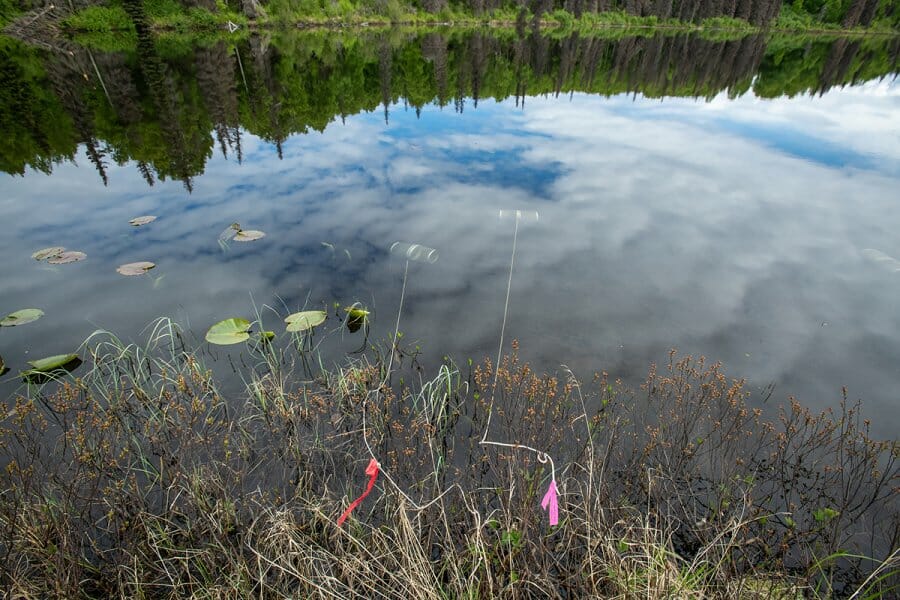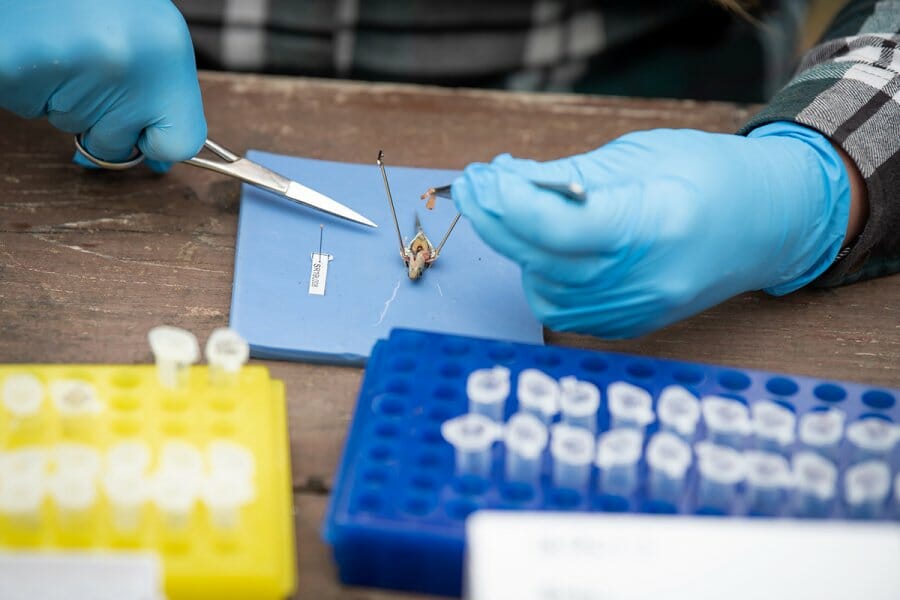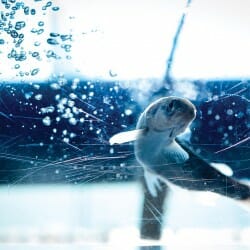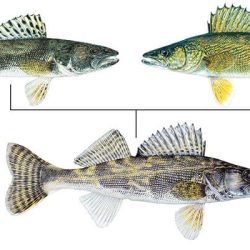
Gut Feelings
While exploring the microscopic similarities that unite species, Kat Milligan-McClellan ’99, PhD’09 embraced her long-rejected Indigenous identity.
It takes guts to do the kind of research that Kat Milligan-McClellan ’99, PhD’09 conducts. Fish guts, to be accurate. It also takes some petri dishes, a good chunk of time, and, most importantly, an understanding of and respect for the environment she’s inevitably changing through her presence there.
Milligan-McClellan is as much influenced by her environment as it is by her. Growing up in the Inupiat community of Kotzebue, Alaska, she was intimately aware of her Indigenous heritage and of the disdain with which she was conditioned to regard it. After spending her adolescence rejecting her Indigeneity in pursuit of whiteness, she found herself on a campus perfectly suited to the latter identity. She also found herself miserable. Science couldn’t explain the painful disconnect between her spirit and her surroundings, but it played a crucial role in resolving it.
Milligan-McClellan — known to students and colleagues as “Dr. Kat” — is a microbiologist and assistant professor in the Department of Molecular and Cell Biology at the University of Connecticut. She was previously an assistant professor of biological sciences at the University of Alaska–Anchorage and a postdoctoral researcher at the University of Oregon. And before she was a Duck, she spent her undergraduate and doctoral studies falling in love with microbiology at UW–Madison. It’s a journey that has brought her about as far as one can get from Kotzebue — literally and, at times, figuratively. But it’s also led her back there.
Like any good research endeavor, Dr. Kat’s started with asking the right questions.
The price of parasitology
Milligan-McClellan’s early career plans put her not behind a microscope, but at a front desk. She attended hotel-administration school at Cornell University with the intention of running Kotzebue’s local tourist mainstay. After quickly realizing that hospitality was not her calling, she traded lobbies for laboratories and headed to UW–Madison, encouraged by friends and family who assured her that she was destined to become a medical doctor. At the UW, she realized that there was still room to contribute to a field of scientific discovery that she once considered finite.
“I didn’t know that the things we learn about in our textbooks came from research labs and that people are actively doing research,” she says. “When I started working in a research lab and we were discovering new things, I was like, ‘This is what I want to do.’ ”
A series of jobs working in labs ranging from plant pathology to studying malaria in mosquitoes brought Milligan-McClellan to her first scientific infatuation: Staphylococcus aureus, an infection-causing bacterium. Later, in her doctoral studies, she switched to the parasite Toxoplasma gondii. Her newfound excitement over microscopic life was less contagious back home, where toxoplasmosis — the infection caused by T. gondii — is an uncommon disease and an even less common term.
“When I was doing all this work, I thought it was very important, and everybody at the university was saying that this is important work. But I would go home, and I would tell my dad and my mom, and they’d [go], ‘Staph-what-now? And toxo-huh?’ ” she says. “I was studying these things that they didn’t know, and it had no impact on their life.”
The disconnect with home wasn’t exclusive to her research. At the same time that Milligan-McClellan was making breakthroughs in the lab, she was struggling to recognize herself. Years of being taught in school and by missionaries that traditional Inupiat lifestyles were backward had conditioned her to reject hallmarks of her heritage.
"By the time I got into grad school, crying in the microscope room was no big deal to me because I just felt so isolated, and I didn't know why."
“When I first started out in research, I was very much into assimilating into Western science and Western culture,” she says. “I didn’t wear my traditional clothes. I only spoke fluent and ‘eloquent’ English. I was just thinking, ‘I am white, and I am going to behave white, and I am not going to pay attention to all of these things my ancestors took 10,000 years to learn.’ ”
But what Milligan-McClellan once saw as the price of acceptance in “lower-48 culture” quickly proved too high a cost.
“That’s really hard on your psyche. I was pretty dang depressed,” she says. “By the time I got into grad school, crying in the microscope room was no big deal to me because I just felt so isolated, and I didn’t know why.”
Stickleback Solution
According to Aaron Bird Bear MS’10, Milligan-McClellan’s feelings of isolation are devastatingly common among Indigenous students. Bird Bear, the UW’s director of tribal relations, is a citizen of the Mandan, Hidatsa, and Diné nations and is enrolled in the Three Affiliated Tribes of North Dakota’s Fort Berthold Reservation.
“The United States only decriminalized Native American language and culture in 1975 [with the Indian Self-Determination and Education Assistance Act], but just because the United States decriminalized Native American language and culture didn’t mean public institutions or broader society suddenly embraced it,” he says. “Native students have to kind of reconcile that at least 80 percent of their peers know little to nothing about Native Americans.”
Milligan-McClellan found the people who did. Through involvement with student groups such as Wunk Sheek and the American Indian Science and Engineering Society (AISES), she surrounded herself with people who encouraged her to embrace elements of the culture that she’d long rejected.
Bird Bear was the American Indian student academic services coordinator in the College of Letters & Science when he first met Milligan-McClellan, then a new graduate student.
“Eagle feathers are the highest award Indigenous people can receive in their own communities, so we would invite students to come pick up an eagle feather to take home and bead it for a few weeks, and we would gift it to our graduates upon graduation,” he says. “Kat came in to pick up an eagle feather and wanted to contribute to recognizing the graduating class of that year.”
He recalls one AISES retreat during which Milligan-McClellan led attendees in Alaska Native winter games, a series of traditional challenges like seal-hops and one-legged kicks. While competitive and amusing, the activities also reflected the skills necessary for surviving in the Arctic north.
“It wasn’t until I started talking with [other Indigenous students] that I started recognizing that I’m ignoring 10,000 years of knowledge,” Milligan-McClellan says. “How does that benefit anybody to ignore that amount of knowledge? To turn my back on a history of strong people who have survived in the world’s harshest conditions for that long — it can only do me a disservice.”
Her newfound campus community was also a reminder of what she missed from Kotzebue. Ever the researcher, she began reaching out to family back in Alaska, asking questions and searching for answers that could strengthen her ties to her ancestral home.
“My aunt Lovie was very gracious and would answer all these questions that I had, and that made me understand that there was somebody in my family who would answer. I wasn’t going to be ostracized for [not knowing more about my heritage],” she says. “She told me, ‘You don’t know this because we were told not to know this. Now you’re learning it, and I think that’s beautiful, and I’m going to welcome you back in.”
But while Milligan-McClellan was in grad school, Aunt Lovie died in a house fire.
“Losing that one person who had so much knowledge … made me realize that it shouldn’t be on one person,” she says. “There should be multiple people who are holding onto that knowledge, and it’s my responsibility to my community to start regaining that.”
Milligan-McClellan began relearning her Inupiat language and incorporating traditional foods back into her diet, but she found that her postdoctoral studies offered a road home as well, and another opportunity to contribute to an existing body of knowledge — this time about her own people. She turned her attention from parasites to beneficial microbes and began studying interactions between host organisms and gut microbiota in wild threespine sticklebacks (Gasterosteus aculeatus), a species of fish found across the Northern Hemisphere, from Connecticut to Kotzebue and beyond.
"'Yeah, you're Native. This is how you can use your Native voice.'"
Glossary
Host
A larger organism that harbors a smaller organism.
Microbe
Microscopic organisms that first evolved 3.5 billion years ago and live … pretty much everywhere. Microbes can be beneficial or harmful. Examples of microbes include bacteria, (both good and bad), viruses, archaea, fungi, and protists.
Microbiome
A community of microorganisms living in a shared habitat.
Studying a host organism’s gut microbiome offers insight into both how the host’s genetics predispose it to certain immune responses to microbiota in the gut and how the organism responds to microbiota introduced into its external environment. MilliganMcClellan intended to study the variations in these relationships across populations in zebrafish under microbiologist Karen Guillemin at the University of Oregon until she agreed to collaborate with Guillemin’s colleague, who was studying stickleback. Initially, she was put off by the complexity of the organism — too many variables to consider. However, the intricacy of the fish proved to be one of its greatest assets, and it’s part of what makes Dr. Kat’s work unique.
Most researchers work with model organisms — think of inbred lab mice, whose diet and environment are meticulously controlled. This is useful for testing one variable at a time, but it doesn’t reflect the unbridled variety of nature. Stickleback allow for a holistic analysis of a complex organism sourced directly from its natural habitat. Thanks to their ubiquity in bodies of water throughout the country, Milligan-McClellan’s lab has been able to assess how each population’s respective environment, available food supply, and stress levels influence its microbiota.
“We were doing collections on Cheney Lake, which is in Anchorage,” she says, “and because we were physically at that lake every month, we could see how clear the water was at different stages. We could see how thick the ice was. We could see that there were bears and moose that wander, but there’s also a lot of people with dogs, and they don’t always pick up the poop. So how is that species of microbe getting into the water, and how is that changing the fish’s microbiome?”
Glossary
Host
A larger organism that harbors a smaller organism.
Microbe
Microscopic organisms that first evolved 3.5 billion years ago and live … pretty much everywhere. Microbes can be beneficial or harmful. Examples of microbes include bacteria, (both good and bad), viruses, archaea, fungi, and protists.
Microbiome
A community of microorganisms living in a shared habitat.
Stickleback also gave her a regular excuse to head back home. Toxoplasmosis may have been a mystery to her family, but fish guts had an immediate relevance. After all, it’s only a short evolutionary jump between stickleback and Homo sapiens. “Billions of years ago, there were microbes,” Milligan-McClellan says. “Then some small things happened, and then there were fish, and then a couple of really insignificant things happened, and then there were humans.”
Blood cells such as B cells, T cells, neutrophils, and macrophages — all of which are crucial to a functioning immune system — are conserved from fish all the way to humans. In Milligan-McClellan’s research, these evolutionary links may indicate that interactions in the gut microbiomes of stickleback are conserved to humans, too. The findings could assist in the research and treatment of diseases such as stomach and gastric cancers, which are common among Alaska Natives.
“There are so many diseases that affect Alaska Natives and Native Americans that are correlated with changes in the microbiome. I thought if I study the impacts of changing the microbiota — and also what changes the microbiota — I might be able to identify something that would be important for people back home,” she says.
Studying stickleback in Alaskan ecosystems also means studying the ecotoxins that permeate what is some of America’s most polluted water: the area around Kotzebue has contaminants such as crude oil, microplastics, and antibiotics. Milligan-McClellan’s lab is identifying microbes that could degrade and reverse the effects of those pollutants in a host’s microbiome.
“These contaminants are in the water that my family uses and that our animals come from and use,” she says, “so these ecotoxicants are potentially harming us, the people of Alaska.”
Now when she returns home with research to share, it’s work that directly impacts her community.
“When I talk to people back home about the research I’m doing, they’re not like, ‘Toxoplasma? Who’s ever heard of that?’ Now, they’re like, ‘Oh, crude oil. Yeah, we’re getting more oil in our waters because of increased boat use or snowmobile use. How do you think that affected the waters?’ ” she says. “The only way we’re going to move past this idea that science only belongs to a specific group of people is if we bring everybody into it.”
LESS LONELY
Milligan-McClellan’s research appreciates a living being for what it is, with all of its nuances and complexities. She appreciates nuance and complexity in people, too — even in herself.
After she arrived at the UW, her loneliness was crippling. By the time she left, Dr. Kat was the first person from her village to receive a doctorate in biological sciences. She’s believed to be the first Indigenous person to receive a doctorate in her department and the 10th Indigenous person to receive a doctorate in a STEM field at the UW. They’re feats that have set her apart in her field, but she takes great comfort in knowing she’s not the “only” anymore.
"The only way we're going to move past this idea that science only belongs to a specific group of people is if we bring everybody into it."
“When I started, I was the only Native STEM person that I knew for a while,” she says. “Now, I’ve got all these people I can talk to about this, and it feels really good to know there are so many of us out there. It’s also awesome because I can tell people, ‘Yeah, you’re Native. This is how you can use your Native voice.’ ”
Milligan-McClellan’s work has also caught the attention of some big names in research. The National Institutes of Health is interested in stickleback for their utility as a model for human diseases and human-microbe interaction. The National Science Foundation has taken an interest in her work as a means of studying the evolution of host-microbe interaction in stickleback, which may offer insight into this evolution in other ecosystems.
“Kat’s really fulfilling all the promises we hope for [regarding] Indigenous scholarship,” Bird Bear says, “being grounded in cultural values and advancing the scientific realm with her unique perspective on how she understands the universe to function through the Inupiat universe that she grew up in.”
While relatively linear when traced on a map from start to finish, the arc of Milligan-McClellan’s journey frequently circles back to Kotzebue. Her research excursions have even come to serve a dual purpose: adding to her data on fish guts and deepening her connection to a place that’s been home to many Inupiat for centuries, and will continue to be for more to come.
“We have been on those lands for over 10,000 years. What does that mean? How does that change the way that I think of the tundra?” she asks. “It changes the way I think of the ecosystem there, which influences the way I think about science, which influences the way I think about people back home. All of it interconnects now. It took me going back as a scientist to see that connection.” •
Megan Provost '20 is a staff writer for On Wisconsin.
Published in the Summer 2022 issue





Comments
No comments posted yet.